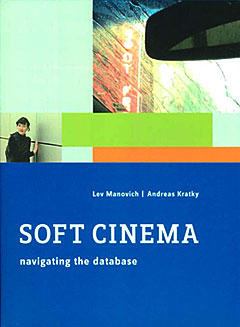Soft Cinema: Navigating the Database Review
Cambridge, Massachusetts: MIT Press
DVD-video with 40 page booklet/$30.00
Originally printed in the September/ October 2005 issue of Afterimage
 In 2001, MIT Press released Lev Manovich’s The Language of New Media, a groundbreaking book in the field of “New Media.” Now, with the 2005 release of the Soft Cinema: Navigating the Database DVD, a three-year collaborative effort with new media artist and designer Andreas Kratky, Manovich puts theory into practice. The Soft Cinema DVD showcases three database-driven films, Mission to Earth (2003-04), Texas (2002) and Absences (2004). The Soft Cinema software creates these movies by selecting and editing media from a database as well as the layout of the screen by using a set of defined parameters for each of the films.
In 2001, MIT Press released Lev Manovich’s The Language of New Media, a groundbreaking book in the field of “New Media.” Now, with the 2005 release of the Soft Cinema: Navigating the Database DVD, a three-year collaborative effort with new media artist and designer Andreas Kratky, Manovich puts theory into practice. The Soft Cinema DVD showcases three database-driven films, Mission to Earth (2003-04), Texas (2002) and Absences (2004). The Soft Cinema software creates these movies by selecting and editing media from a database as well as the layout of the screen by using a set of defined parameters for each of the films.
Each film has a quilt-like interface design that utilizes a subdued color palette. Multiple video clips play simultaneously with scrolling text. A narrator’s voice sometimes weaves in and out. In a December 2004 interview with this author (for the forthcoming documentary Outside the Box: New Cinematic Experiences), Manovich stated that the interface design draws from a number of different sources. “The compositions…make reference to abstract paintings from Mondrian … [but also refer] … to the kind of layouts you see in financial TV shows … as well as displays used by people in a variety of professions such as pilots, surgeons, brokers.”
Mission to Earth is a story about Inga, an alien who comes to Earth from the planet Alpha-1, a world that is about 20 years behind Earth culturally and technologically. Manovich writes in the companion booklet that film is, “an allegory of both the Cold War era and of the contemporary immigrant experience that is so frequently the norm for inhabitants of ‘global cities.’”
Texas, is described as an “experiment in ‘pure’ database aesthetics…[that]… assembles its visuals, sounds, narratives and even the identities of its characters from multiple databases.” Much like a contemporary news program, streams of video flash on the screen allowing the viewer to see several windows of fragmented imagery. The voice narration along with text describes various disjointed events centered in a restaurant.
In Absences, the surreal black and white imagery works loosely in conjunction with the soundtrack, while fragments of dialogue-based text occasionally scroll across the screen. The sequencing “relies on the algorithms normally deployed in military and civilian surveillance applications to determine the editing of video and audio.”
Manovich also remarked, “I want to show that there are lots of other, perhaps more radical, more unusual, more poetic ways to combine film/cinematic tradition with the digital computer … I decided that to make a kind of real digital cinema would mean that all the constants of traditional film become variable, and the computer is a wonderful machine that allows us to do it.” The Soft Cinema DVD presents the viewer with a pared-down version of the films in the Soft Cinema installations but in the DVD version after between eight and twenty-four minutes, each film returns to the main menu. As a result, the DVD will not run infinitely as the installations are designed to do. Manovich writes, “Consequently there is no single ‘unique’ version of each film.”
The Soft Cinema DVD and companion booklet, which includes architectural designs and documentation of the Soft Cinema installations and an interview with Lev Manovich, is an excellent resource for educators, students and film buffs. Reading The Language of New Media would perhaps also lend a greater appreciation of the work and theory behind the Soft Cinema project.